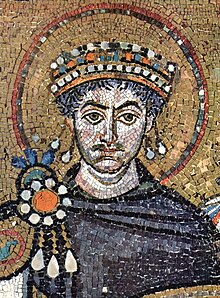Pendilien


As pendilia (of lat. : Pendulus "suspended" from Medieval-. : Pendulum "hanger") are jewelery chains or tag to diadems , crowns , earrings , brooches referred to and other jewelry. The strips of fabric on papal tiaras and episcopal mitres that fall on the neck are also called 'pendilies'.
history
The historical origin of the pendilies is largely in the dark - they are extremely rare on early pieces of jewelry (exception: diadem from the so-called treasure of Priam ). A protective, possibly also fastening function is possible on helmets; on the other hand, they could originally have had a veiling function - especially with women. The fact that they attract glances could also be related to disaster-defensive ( apotropaic ) ideas. Another possibility would be that they come from the end pieces of headbands hanging down at the neck, v. a. of Hellenistic tiara and royal bandages .
Examples
With the Byzantine Emperor Justinian I and his wife Theodora , pendilies can be found on almost all pieces of jewelry. What is striking is the fact that the pendilies on Theodora's crown are significantly longer than those on her husband.
Impressive examples from the early Middle Ages are the pendilies set with precious stones and pearls on the Visigoth consecrated crowns . Some of the German imperial crowns of the High Middle Ages still had pendilies, but most of them have been lost; they are still preserved in the Hungarian St. Stephen's Crown . The pendilies disappeared from the crowns of modern times. On the other hand, in the tiaras of the Roman popes and the mitres of the Catholic bishops, their possible textile origin is still clearly recognizable.
Jewelry pendants can be found today on a wide variety of jewelry ( earrings , necklaces , bracelets, etc.)
symbolism
In addition to their decorative function, which enlarges the actual piece of jewelry and / or attracts attention through movement, pendilies also have sovereign implications, which is clear both in the imperial crowns and in papal or episcopal headgear.
literature
- Thomas Heller: The imperial regalia with special consideration of the imperial crown. GRIN-Verlag, Munich 2010, ISBN 978-3-640-55329-7 , p. 10 f.
- Hermann Fillitz : Origin and Change of the Imperial Crown. In: Tobias Frese, Annette Hoffmann, Katharina Bull (eds.): Habitus. Norm and transgression in text and images. Festival for Lieselotte E. Saurma-Jeltsch. Akademie-Verlag, Berlin 2011, ISBN 978-3-05-005094-2 , pp. 259-264.